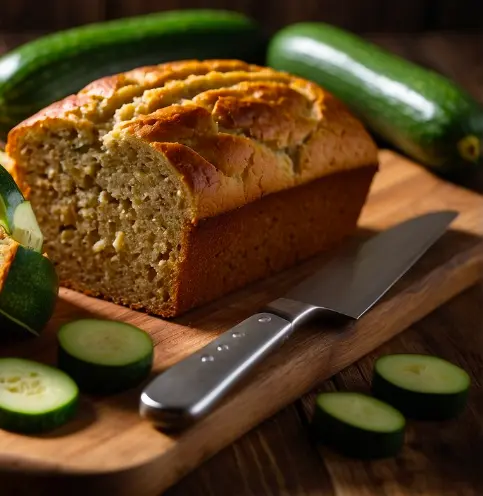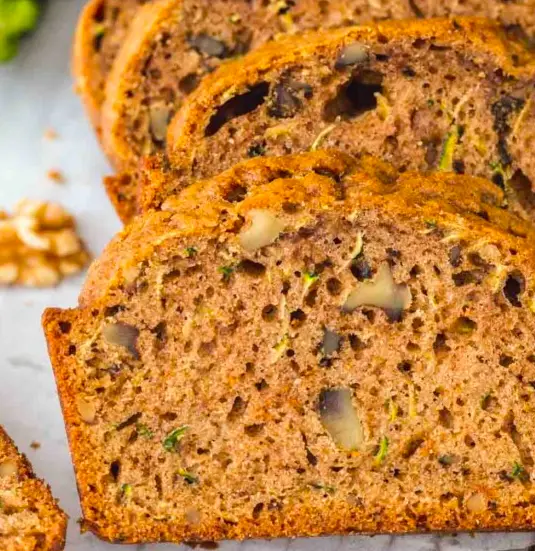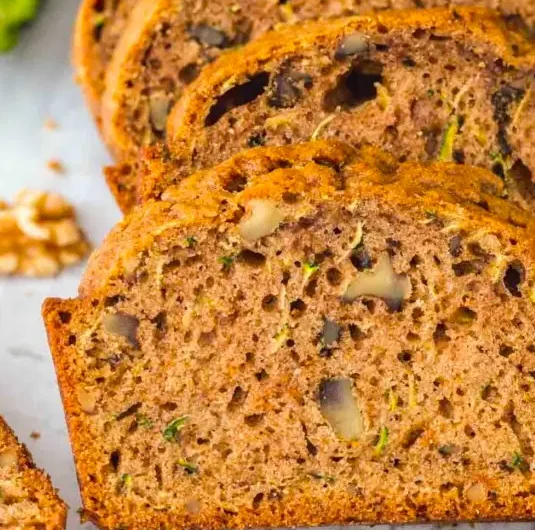There’s something uniquely comforting about the taste of Amish zucchini bread. In my own kitchen, the process of grating the zucchini and mixing it into a rich, spiced batter feels like a connection to a simpler time. This bread is not just a treat; it’s a slice of tradition. With the versatility of zucchini, a vegetable that blends seamlessly into the moist crumb of the bread, each loaf is a testament to the resourcefulness of Amish cooking.

My journey with this old-fashioned zucchini bread began with a search for a recipe that encapsulates the warmth of Amish hospitality. I wanted a bread that could be enjoyed at any time of the day, whether as a quick breakfast or a sweet afternoon snack. After numerous trials and tastings, I’ve landed on a formula that captures the essence of this countryside classic. The result is a delicious Amish zucchini bread recipe that features the delicate texture and harmonious flavors cherished in the community.
Sharing recipes is a cornerstone of Amish culture, often considered an extension of friendship. This notion gave rise to the concept of Amish friendship breads, like my zucchini bread, meant to be shared among close ones. The act of passing along a loaf is not just about sharing food but about fostering connections. This recipe merges that spirit of generosity with the down-to-earth goodness of home-baked bread, embodying the heart of Amish culinary traditions.
Essential Ingredients

When I bake Amish zucchini bread, selecting quality ingredients is paramount. Focusing on the essential components that comprise the dry and wet ingredients, as well as additional flavor add-ins, ensures a delectable outcome. Each category contributes to the overall taste and texture of the bread.
Dry Ingredients
My go-to dry ingredients for Amish zucchini bread encompass:
- 2-3 cups of all-purpose flour: the base that gives structure
- 1 teaspoon of baking soda: for leavening and a tender crumb
- 1 teaspoon of salt: which balances the flavors
- A sugar mixture, usually combining white and brown sugar: for sweetness and moisture
Wet Ingredients
In a separate bowl, I combine the following wet ingredients:
- 4 large eggs: which bind the ingredients and add richness
- 1 cup of vegetable oil: for a moist crumb and tender texture
- 2 teaspoons of vanilla extract: for a hint of warmth and complexity
- 2 cups of freshly shredded zucchini: this is crucial for authentic Amish zucchini bread, lending moisture and nutrition
Additional Flavor Add-Ins
Occasionally, I like to enhance my zucchini bread with:
- Chocolate chips: for a sweet, melty surprise
- Chopped nuts: kinds like walnuts or pecans, for extra crunch and flavor
| Zucchini Bread Flavor | Ingredients |
|---|---|
| Classic | Zucchini, flour, sugar, eggs, oil, baking powder |
| Chocolate Chip | Zucchini, flour, sugar, eggs, oil, chocolate chips |
| Lemon Poppy Seed | Zucchini, flour, sugar, eggs, oil, lemon zest, poppy seeds |
| Walnut | Zucchini, flour, sugar, eggs, oil, walnuts |
| Blueberry | Zucchini, flour, sugar, eggs, oil, blueberries |
These ingredients are always carefully measured and combined to create a loaf that is not only traditional but also tailored to my personal taste preferences.
Preparation Basics
In preparing an Amish zucchini bread, I ensure to handle the zucchini correctly, mix my ingredients thoroughly, and bake the bread to perfection.
Preparing the Zucchini
Before anything else, I wash my zucchini and pat it dry with a paper towel. Using a box grater, I shred the zucchini, being careful to remove any excess moisture which can make the bread too soggy. If there’s any leftover, I wrap the extra zucchini in plastic wrap and store it in an airtight container in the fridge.
Mixing Ingredients
In a large mixing bowl, I combine the dry ingredients to create the flour mixture. In a separate bowl, I beat the eggs, oil, and sugar. Then, I carefully fold the wet ingredients into the dry ones, ensuring not to overmix to maintain the bread’s tender crumb.
Baking the Bread
I preheat my oven and ensure it’s at the correct temperature – a preheated oven is crucial for an even bake. I then pour the batter into greased loaf pans, making sure to level off the top for an even rise. After baking, I let the bread cool before wrapping in plastic wrap to maintain its moisture. If there’s excess liquid, I sometimes put a paper towel at the bottom of container to absorb it.
Baking Tools and Equipment
When I bake Amish zucchini bread, having the correct equipment on hand is essential to ensure a perfect loaf every time. It streamlines the process and contributes to the even baking and texture of the bread.
Choosing the Right Pan
For Amish zucchini bread, a 9×5-inch loaf pan is ideal. It’s the perfect size for the bread to rise and bake properly without the edges becoming too dark before the center is fully baked. I usually opt for an aluminum pan because it conducts heat evenly, ensuring a consistent bake throughout. Before pouring the batter into the pan, I line it with aluminum foil or cooking spray to prevent sticking. This also makes for easier cleanup. If I notice my bread requires additional bake time, I tent the top with aluminum foil to prevent over-browning.
Mixing and Measuring Utensils
Accurate measurements are key to a flawless zucchini bread. I use a set of dry and liquid measuring cups and spoons for precision. I typically shred zucchini using a food processor because it saves time and provides uniform pieces for even distribution throughout the bread. After combining the wet and dry ingredients in a large bowl, I mix until just incorporated to prevent overworking the dough. Once mixed, I transfer the batter to my previously greased loaf pans. After baking, I let the bread rest on a wire rack to cool down; this allows air to circulate and prevents the bottom from becoming soggy.
Storage and Preservation
Appropriate storage of Amish zucchini bread ensures its freshness and flavor are maintained. I’ll guide you through the best practices for room temperature storage and how to freeze this delicious quick bread for later use.
Storing at Room Temperature
To keep Amish zucchini bread fresh at room temperature, it’s essential to store it in an airtight container. I typically use aluminum foil or plastic wrap to cover the bread, which helps prevent it from drying out. Ensure it’s wrapped tightly to keep moisture in and preserve its soft texture.
- Step 1: Wrap the zucchini bread with plastic wrap.
- Step 2: Place it in an airtight container.
- Step 3: Store in a cool, dry place.
Freezing for Later Use
When I want to keep my Amish zucchini bread longer than a few days, freezing is my go-to method. I make sure to wrap the bread tightly with aluminum foil or plastic wrap. Then, I place it in freezer bags, squeezing out as much air as possible. Stored this way, the bread stays fresh for up to 3 months.
- Freezing Steps:
- Wrap in aluminum foil or plastic wrap.
- Place inside freezer bags.
- Label the bag with the date.
By following these storage tips, your Amish zucchini bread will remain a delightful treat for days or even months.
Serving Suggestions
When I bake my Amish Zucchini Bread, I look for ways to enhance the overall dining experience. I focus on complementing dishes that pair well and presentation tips that make the bread even more inviting.
Complementing Dishes
- Main Courses: Amish zucchini bread is a versatile side that pairs excellently with savory main courses. I often serve it alongside a roast chicken or beef stew, where its slightly sweet flavor complements the richness of these dishes.
- Family Reunions & Holiday Gifts: During larger gatherings like family reunions, slices of this bread can be a delightful addition to a buffet spread. As for holiday gifts, a loaf wrapped in a decorative dish towel ties in the homemade, personal touch.
Presentation Tips
- Slices: I always use a butter knife to cut even slices, roughly about half an inch thick. This showcases the bread’s moist interior and the fresh zucchini specks.
- Favorite Recipes: Displaying a printed card with the recipe can be a thoughtful gesture, allowing guests to see why this is among my favorite recipes and perhaps inspire them to create delicious ways to enjoy it at home.
Using a bread basket lined with a linen napkin not only adds a rustic touch to the presentation but also keeps the bread warm for serving. My aim is to provide not just a delectable slice, but an experience that resonates with comfort and care.
Alternative Variations
When I make Amish zucchini bread, I often explore alternative variations to keep the recipe exciting and cater to different dietary needs or taste preferences. Below are some specific variations I’ve tried and found successful.
Nut and Seed Inclusions
To add a bit of crunch and nutritional value to the bread, I sometimes include nuts and seeds. Here’s how I do it:
- Walnuts/Pecans: For a classic touch, I fold in 1 cup of chopped walnuts or pecans into the batter before baking. Zucchini pecan bread is a particularly delightful variation with its rich, nutty flavor.
- Sunflower Seeds: Sometimes, a 1/2 cup of sunflower seeds mixed into the batter can give a surprising crunch and a healthier twist.
Remember to chop the nuts roughly for a more interesting texture within the bread.
Gluten-Free Options
For those avoiding gluten, replacing the regular flour with a gluten-free alternative is a must. Here’s a simple switch:
- Almond Flour: Almond flour can be used as a substitute for all-purpose flour to achieve a smoother texture and a slightly nuttier flavor.
- Mix of Flours: Combining almond flour with another gluten-free flour, such as oat or coconut flour, may help replicate the structure and moistness of traditional zucchini bread.
Experimenting with the ratios is key to finding the perfect gluten-free blend for your taste.
Sweetness Adjustments
Adjusting the level of sweetness can transform Amish zucchini bread from a breakfast item to a dessert-worthy treat. Here are modifications I recommend:
- Reduce Sugar: For a less sweet bread, I reduce the sugar in the recipe by up to 25%. This is great for those who prefer a subtler sweetness or want a healthier option.
- Chocolate Chips: Adding chocolate chips to the batter introduces pockets of sweet, melty chocolate, making the bread a delicious treat that resembles more of a dessert.
As you try these variations, keep in mind my suggested inclusions and adjustments to ensure your Amish zucchini bread retains its characteristic moisture and richness, while offering a new twist on the traditional recipe.
Creating Your Own Zucchini Bread Recipe
When I set out to craft a zucchini bread recipe for my own personal cookbook, I focused on a few key elements. First, quality ingredients are paramount—smaller zucchini tend to be more flavorful and less watery, making them ideal. I grate them finely, ensuring they meld perfectly into the batter.
I start with the basics: flour, sugar, and eggs. Then, I reach for my Amish friendship bread starter; it’s a traditional ingredient that gives the bread a distinct depth of flavor. Handling this living ingredient requires care; I store my starter in a mason jar, feeding it regularly to keep it active.
The process is straightforward. I combine the dry ingredients in one bowl, the wet in another, and then marry the two. My zucchini is folded in last, along with a blend of spices that I’ve fine-tuned over time. I pour the batter into a pre-greased loaf pan and bake at 350 degrees F. The best way to tell it’s done is to test the center of the bread with a toothpick—it should come out clean when the bread is golden brown.
I’m always excited to put a new recipe in my own personal family cookbook, and this zucchini casserole – delicious twist to bread has become a huge fan favorite. With each loaf, I adjust spices or add-ins like nuts or dried fruit, making it uniquely mine. I’ve found that this bread not only satisfies my taste buds but also offers a modest amount of vitamin C, thanks to the zucchini.
Every time I bake this bread, it feels like creating a newer post for my home kitchen blog, and I can’t wait to see what variations I’ll dream up next time!
Frequently Asked Questions
In exploring Amish zucchini bread, I’ve come across some common inquiries. Below, I address these questions to help enhance your baking experience.
What is the best way to incorporate sour cream into a zucchini bread recipe?
To incorporate sour cream into zucchini bread, I mix it with the wet ingredients until smooth before folding it into the dry mixture. This ensures even distribution and added moisture for a tender crumb.
Can zucchini bread be made healthier without compromising taste?
Yes, it’s possible to make zucchini bread healthier. I often substitute apple sauce for oil and use whole wheat flour instead of all-purpose for added fiber, ensuring the taste remains delightful.
What adjustments should be made when baking a large batch of zucchini bread?
When baking a large batch, I adjust the oven temperature slightly lower and rotate the pans to promote even baking. I also ensure not to crowd the oven so that heat circulates properly.
How does adding nuts or pineapple change the texture or flavor of zucchini bread?
Adding nuts to zucchini bread introduces a pleasant crunch and rich flavor, while pineapple brings a moist texture and a hint of tropical sweetness that complements the zucchini.
How can I prevent my zucchini bread from falling in the middle during baking?
To prevent zucchini bread from falling in the middle, I make sure not to over-mix the batter and check that my leavening agents are fresh. Baking at the right temperature is also crucial.
What are the keys to achieving a moist zucchini bread?
The keys to moist zucchini bread include using fresh zucchini, not squeezing out its natural moisture, and measuring ingredients accurately. A proper balance of ingredients is vital.
Traditional Amish Zucchini Bread
Course: LunchCuisine: AmishDifficulty: Easy8
servings15
minutes1
hourThis classic Amish zucchini bread is moist, flavorful, and perfect for using up an abundance of zucchini from your garden!
Ingredients
2 cups grated zucchini
3 cups all-purpose flour
1 teaspoon baking powder
1/2 teaspoon baking soda
1 teaspoon salt
1 tablespoon ground cinnamon
1/2 teaspoon ground nutmeg
3 large eggs
1 cup vegetable oil
2 cups granulated sugar
2 teaspoons vanilla extract
1 cup chopped nuts (optional)
Directions
- Preheat your oven to 350°F (175°C). Grease and flour two 9×5-inch loaf pans.
- In a large bowl, combine the grated zucchini, flour, baking powder, baking soda, salt, cinnamon, and nutmeg. Stir until well combined.
- In another bowl, beat the eggs. Add the vegetable oil, granulated sugar, and vanilla extract. Mix until smooth.
- Gradually add the wet ingredients to the dry ingredients, stirring until just combined. Be careful not to overmix. If using nuts, fold them into the batter at this stage.
- Pour the batter into the prepared loaf pans, dividing it evenly between the two pans.
- Bake in the preheated oven for 50 to 60 minutes, or until a toothpick inserted into the center comes out clean.
- Remove the pans from the oven and let the bread cool in the pans for 10 minutes. Then, transfer the loaves to a wire rack to cool completely.
- Once cooled, slice and serve the zucchini bread.
Notes
- This zucchini bread freezes well. Wrap individual slices or the entire loaf tightly in plastic wrap and aluminum foil before freezing.

